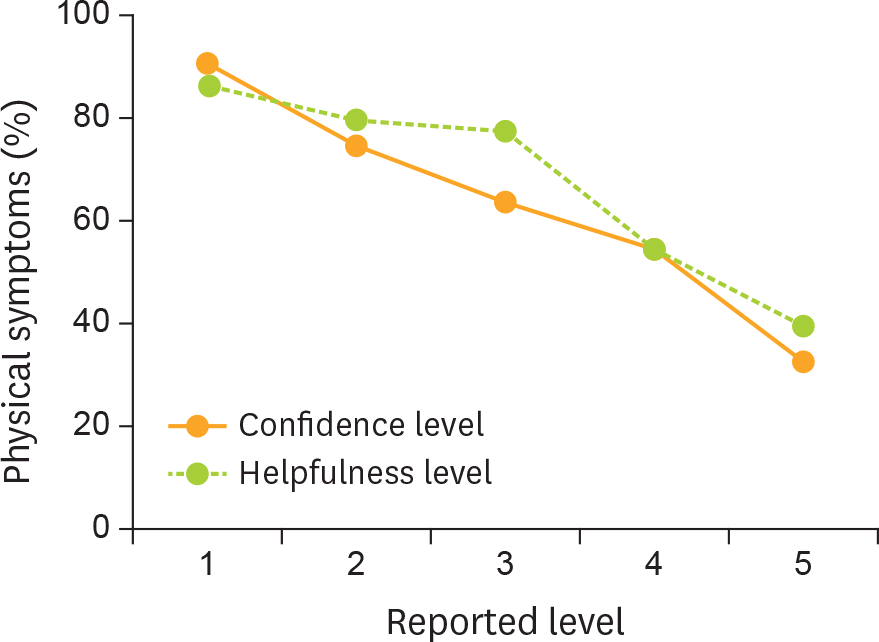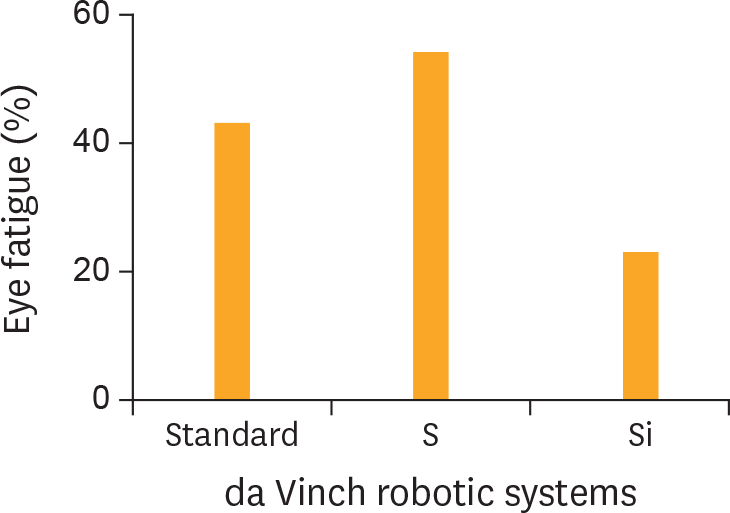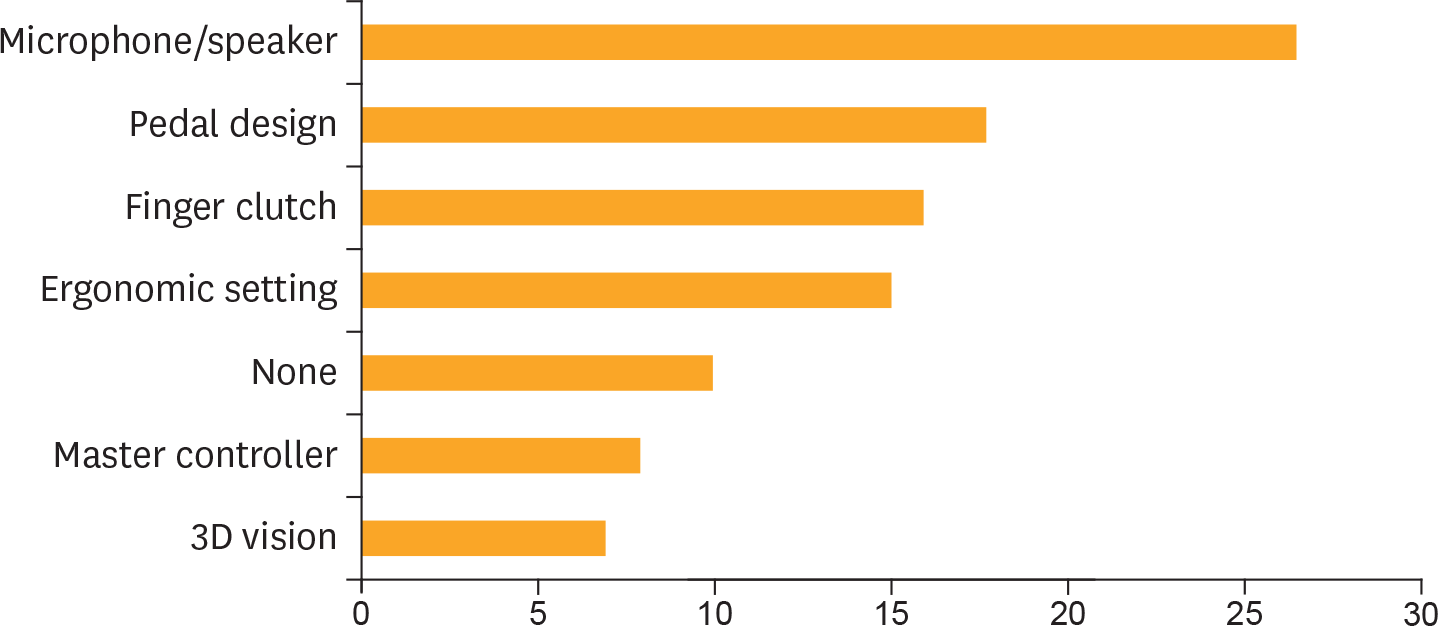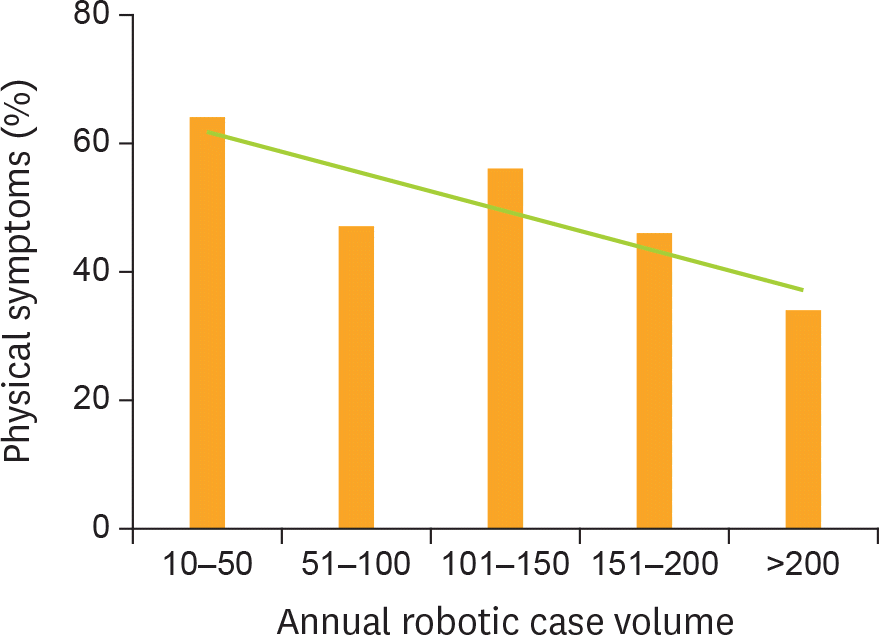Abstract
Objective
To better understand the ergonomics associated with robotic surgery including physical discomfort and symptoms, factors influencing symptom reporting, and robotic surgery systems components recommended to be improved.
Methods
The anonymous survey included 20 questions regarding demographics, systems, ergonomics, and physical symptoms and was completed by experienced robotic surgeons online through American Association of Gynecologic Laparoscopists (AAGL) and Society of Robotic Surgery (SRS).
Results
There were 289 (260 gynecology, 22 gynecology-oncology, and 7 urogynecology) gynecologic surgeon respondents regularly practicing robotic surgery. Statistical data analysis was performed using the t-test, χ2 test, and logistic regression. One hundred fifty-six surgeons (54.0%) reported experiencing physical symptoms or discomfort. Participants with higher robotic case volume reported significantly lower physical symptom report rates (p<0.05). Gynecologists who felt highly confident about managing ergonomic settings not only acknowledged that the adjustments were helpful for better ergonomics but also reported a lower physical symptom rate (p<0.05). In minimizing their symptoms, surgeons changed ergonomic settings (32.7%), took a break (33.3%) or simply ignored the problem (34%). Fingers and neck were the most common body parts with symptoms. Eye symptom complaints were significantly decreased with the Si robot (p<0.05). The most common robotic system components to be improved for better ergonomics were microphone/speaker, pedal design, and finger clutch.
Conclusion
More than half of participants reported physical symptoms which were found to be primarily associated with confidence in managing ergonomic settings and familiarity with the system depending on the volume of robotic cases. Optimal guidelines and education on managing ergonomic settings should be implemented to maximize the ergonomic benefits of robotic surgery.
Go to : 
References
2. Seideman CA, Bagrodia A, Gahan J, Cadeddu JA. Robotic-assisted pyeloplasty: recent developments in efficacy, outcomes, and new techniques. Curr Urol Rep. 2013; 14:37–40.

3. Patel VR, Tully AS, Holmes R, Lindsay J. Robotic radical prostatectomy in the community setting–the learning curve and beyond: initial 200 cases. J Urol. 2005; 174:269–72.

4. Martino MA, Berger EA, McFetridge JT, Shubella J, Gosciniak G, Wejkszner T, et al. A comparison of quality outcome measures in patients having a hysterectomy for benign disease: robotic vs. non-robotic approaches. J Minim Invasive Gynecol. 2014; 21:389–93.

6. Seco M, Cao C, Modi P, Bannon PG, Wilson MK, Vallely MP, et al. Systematic review of robotic minimally invasive mitral valve surgery. Ann Cardiothorac Surg. 2013; 2:704–16.
7. Griffin L, Feinglass J, Garrett A, Henson A, Cohen L, Chaudhari A, et al. Postoperative outcomes after robotic versus abdominal myomectomy. JSLS. 2013; 17:407–13.

8. Liu H, Lu D, Wang L, Shi G, Song H, Clarke J. Robotic surgery for benign gynaecological disease. Cochrane Database Syst Rev. 2012. CD008978.

9. Nieboer TE, Johnson N, Lethaby A, Tavender E, Curr E, Garry R, et al. Surgical approach to hysterectomy for benign gynaecological disease. Cochrane Database Syst Rev. 2009. CD003677.

10. Advincula AP, Wang K. Evolving role and current state of robotics in minimally invasive gynecologic surgery. J Minim Invasive Gynecol. 2009; 16:291–301.

11. Lee EC, Rafiq A, Merrell R, Ackerman R, Dennerlein JT. Ergonomics and human factors in endoscopic surgery: a comparison of manual vs telerobotic simulation systems. Surg Endosc. 2005; 19:1064–70.

12. Stefanidis D, Hope WW, Scott DJ. Robotic suturing on the FLS model possesses construct validity, is less physically demanding, and is favored by more surgeons compared with laparoscopy. Surg Endosc 2011;25:2141–6.
13. Stefanidis D, Wang F, Korndorffer JR Jr, Dunne JB, Scott DJ. Robotic assistance improves intracorporeal suturing performance and safety in the operating room while decreasing operator workload. Surg Endosc. 2010; 24:377–82.

14. Berguer R, Smith W. An ergonomic comparison of robotic and laparoscopic technique: the influence of surgeon experience and task complexity. J Surg Res. 2006; 134:87–92.

15. Hubert N, Gilles M, Desbrosses K, Meyer JP, Felblinger J, Hubert J. Ergonomic assessment of the surgeon's physical workload during standard and robotic assisted laparoscopic procedures. Int J Med Robot. 2013; 9:142–7.

16. Klein MI, Warm JS, Riley MA, Matthews G, Doarn C, Donovan JF, et al. Mental workload and stress perceived by novice operators in the laparoscopic and robotic minimally invasive surgical interfaces. J Endourol. 2012; 26:1089–94.

17. van der Schatte Olivier RH, Van't Hullenaar CD, Ruurda JP, Broeders IA. Ergonomics, user comfort, and performance in standard and robot-assisted laparoscopic surgery. Surg Endosc. 2009; 23:1365–71.

18. Lee GI, Lee MR, Clanton T, Sutton E, Park AE, Marohn MR. Comparative assessment of physical and cognitive ergonomics associated with robotic and traditional laparoscopic surgeries. Surg Endosc. 2014; 28:456–65.

19. Lawson EH, Curet MJ, Sanchez BR, Schuster R, Berguer R. Postural ergonomics during robotic and laparoscopic gastric bypass surgery: a pilot project. J Robot Surg. 2007; 1:61–7.

20. Craven R, Franasiak J, Mosaly P, Gehrig PA. Ergonomic deficits in robotic gynecologic oncology surgery: a need for intervention. J Minim Invasive Gynecol. 2013; 20:648–55.

21. Park A, Lee G, Seagull FJ, Meenaghan N, Dexter D. Patients benefit while surgeons suffer: an impending epidemic. J Am Coll Surg. 2010; 210:306–13.

Go to : 
 | Fig. 3.Correlation between physical symptoms and the confidence level in ergonomic setting management and the helpfulness level for better ergonomics. |
 | Fig. 4.Correlation between the da Vinci robotic system generations and eye fatigue reporting. Standard, first generation; S, second generation; Si, third generation. |
Table 1.
Survey instrument




 PDF
PDF Citation
Citation Print
Print




 XML Download
XML Download